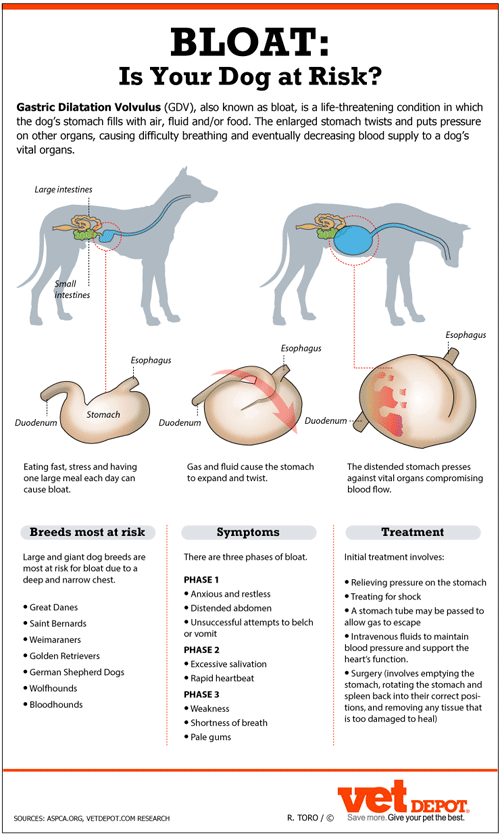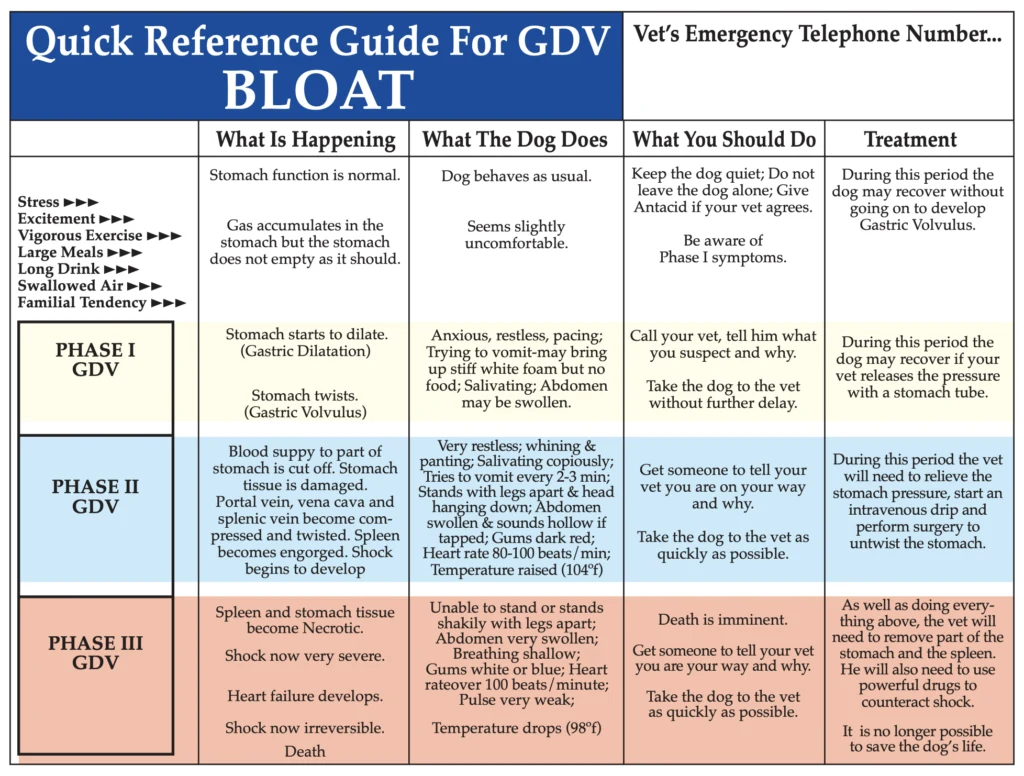The most common fear in Great Dane owners is one word, bloat. I’m here to help dane owners understand bloat in Great Danes. If you have a Great Dane and haven’t heard of bloat, torsion, or GDV then listen up, you’re gonna want to hear this.
Bloat is one of the top causes of death in Great Danes and also affects many other large chested breeds. Bloat is just the conversational term but the technical term is gastric dilatation and volvulus. Often times people will just say bloat, but whether their dog has bloated, or experienced torsion is very different.
In the first stages of GDV, many dogs will experience the distended stomach and initial bloat symptoms, however a dog can definitely bloat without the stomach twist or gastrointestinal torsion. But, in any case it’s just as serious.
What is Bloat
Bloat and GDV is when your dog takes in an overwhelming amount of air and/ or gas that in turn fills up it’s stomach to blow up like a balloon (this is the bloat part). Because of their deep chest and their stomach having a lot of room to move, the accumulation of gas can cause the stomach to rotate or twist (this twist being the torsion) on it’s axis cutting off circulation to other organs, blood supply to other veins and major arteries, and loss of blood flow throughout the body.
Bloat, GDV, and torsion are all typically used interchangeably but their outcomes are vastly different.
A dog can bloat, and while it’s still an emergency it’s easier for vet staff to remove air from the stomach and the dog is likely good to go.
However, if bloat has turned into GDV or torsion, that means the stomach has already flipped cutting off circulation and it could be a matter of minutes that your dog may pass.
It’s extremely important in either scenario that you get your dog to the vet ASAP.
What Causes Bloat
I wish we knew all the answers here to be honest. Truth is, there are so many research studies on so many avenues of bloat and basically whatever you want to find on the internet, you’ll find. It’s so easy to find information to support your thinking. Some common suggestions are raised feeders or not, genetics or not, stress or not, activity or not, etc.
In my personal experience (Cash has bloated without torsion, twice) it wasn’t related to food, at least not that I could correlate, and it wasn’t related to activity. It could have been stress, though he’s not an anxious dog, so then I wonder if it might be genetic.
We’ve had a Great Dane at the Sanctuary bloat 3 times. THREE. with torsion every time and his was all stress induced, at least we think.
Raised Feeders
Honestly when it comes to raised feeders or not, I still suggest that you can find research on both ends of this coin.
Find what works best for your dog. Do they look uncomfortable eating from the floor? Do they seem uncomfortable drinking from water too high?
I tried all the things because I didn’t know what to do and felt overwhelmed, so I let Cash choose. He eats his food from a raised feeder about 12″ off the ground and then he prefers to drink his water from the floor. I’ve tried to put his water up and he refuses to drink from anywhere but the floor. I trust he knows what is best.
Activity
Of all things that are suggested about bloat, I am still extremely cautious of activity before and after meals.
For some reason, this theory makes sense to me. Their stomach is filled with gas/air from panting with extreme exercise and then you load that up with food there is room for that food to expand, let off any internal gasses that it does, overall causing your dog to be more prone to bloat in that moment.
Or your dogs stomach is already full of food and then it goes and runs around, shaking things up.
Stress
Stress falls right in line with activity in my perspective. High stress situations cause extreme panting, and gulping for air. Overall stress has a huge part of how your body responds.
The Whole Dog Journal has a great article about bloat and they mention “Personality and stress also seem to play a role. Dr. Glickman’s research found that risk of GDV was increased by 257 percent in fearful dogs versus nonfearful dogs. Dogs described as having a happy personality bloated less frequently than other dogs”
Genetics
While we don’t have enough information here. It is also thought that bloat and GDV can be genetically linked. Currently the GDCA has been working on studies. This study by the American College of Veterinary Surgeons, just briefly mentions that it’s likely that your Great Dane will bloat if other dogs related have also bloated.
Perhaps the genetics also goes into looking at the structure and composition of how the dogs of that gene are built?
Hopefully this study will give us more information down the line.

Signs/Symptoms of Bloat
Let’s get down to business. If you think your dog is bloating, read this quickly and get to the ER, ASAP.
- Distended stomach
- Pacing
- Not able to get comfortable
- Unproductive vomiting
- Heavy drooling– thick white foam, way different than your average drool strings
- Fast breathing
- Increased heart rate and pulse
- Pale gums
- Collapse
- Unconsciousness
When Cash bloated– no torsion thank goodness– he had the distended stomach, was pacing and extremely uncomfortable. They typically hang their head low and are struggling to vomit. You’ll see the thickets white foam drool you’ve ever seen and you’ll know.
There is no time to second guess yourself. Get to the doc, as soon as possible. I always recommend calling ahead to let them know that you are on the way with potential bloat and torsion. Make sure they have the room to get your dog into surgery right away.
What Does the Vet Visit Look Like?
They will likely rush your dog back to take xrays, this will help confirm if the stomach has flipped/ torsion has occurred. If torsion hasn’t occurred they can stick a tube down their throat and let the gas out through the mouth.
If the stomach has flipped they will need to perform immediate surgery and there is a chance your dog might not make it. It’s best to go into this situation will full expectations of what might happen here and hope for the best. This surgery is typically $3,000- $5,000 depending on location, prices, severity, etc.
Preventing Bloat
While there is no cure or guaranteed prevention for bloat, there are things to be aware of that will help you buy time until you can get to the vet.
Prophylactic Gastropexy
This is also known as a stomach tack, or tack, or pexy, amongst the Great Dane Community.
The Gastropexy procedure is typically recommended at the time of spay or neuter, when the dog is full grown or mostly matured around the age of 15-24 months. If you are spaying or neutering your dog before then, just consider the risk of the pexy not holding.
This procedure basically tacks the internal stomach lining to the abdominal wall so that in the event your dog bloats, that stomach tack holds the stomach in places to hopefully prevent the act of torsion, or stomach flipping.
This does not guarantee that your dog will not have torsion, so if you see the symptoms of bloat, you still need to rush to the ER. This is only buying you time to get there.
The Gastropexy an be a very invasive procedure so it is only recommended to be done at the time of spay or neuter.
Many people often ask my if it’s worth it. 100% agree it’s worth it, the pexy saved Cash’s life. Twice.
Over the counter meds
Many Great Dane owners always carry Gas X and when they notice that perhaps their dog is showing signs of bloat, will pop a few capsules of Gas X (I have not done this, and do not know the dosages, please do more research if you plan to have this on hand) to help relieve the gas bubbles that are accumulating in the stomach. Again, this helps buy you time but bloat is always an emergency issue- I honestly cannot stress that enough.
I have also read a small snippet suggesting that Rescue Remedy can help ease the trauma that comes with bloat. Again, I urge you to do your research here to see if it’s an option for you.
While I really hope this doesn’t happen to you, it’s best to be prepared. I prefer this photo to be posted on the fridge so all family members can see the signs. I have given it to my mom, my sister, my friends, and anyone that has to babysit Cash if I’m out of town.
